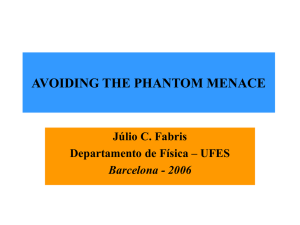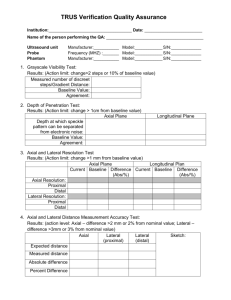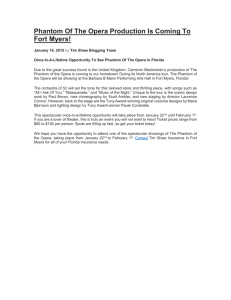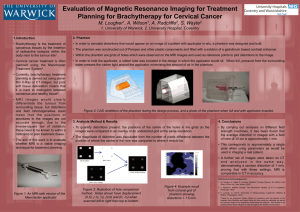TG-128: Quality Assurance for Prostate Brachytherapy Ultrasound -plus TG-154 on US-guided EBRT 8/12/2011
advertisement
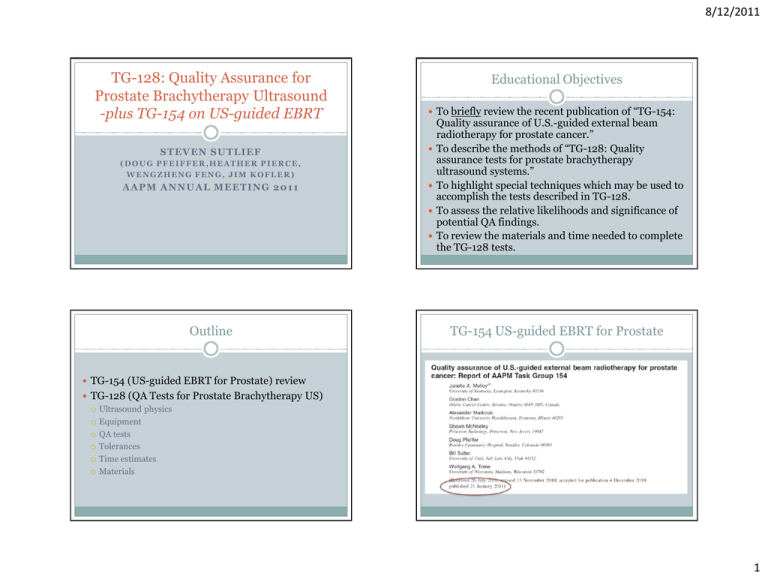
8/12/2011 TG-128: Quality Assurance for Prostate Brachytherapy Ultrasound -plus TG-154 on US-guided EBRT STEVEN SUTLIEF Educational Objectives To briefly review the recent publication of “TG-154: (DOUG PFEIFFER,HEATHER PIERCE, WENGZHENG FENG, JIM KOFLER) AAPM ANNUAL MEETING 2011 Outline Quality assurance of U.S.-guided external beam radiotherapy for prostate cancer.” To describe the methods of “TG-128: Quality assurance tests for prostate brachytherapy ultrasound systems.” To highlight special techniques which may be used to accomplish the tests described in TG-128. To assess the relative likelihoods and significance of potential QA findings. To review the materials and time needed to complete the TG-128 tests. TG-154 US-guided EBRT for Prostate TG-154 (US-guided EBRT for Prostate) review TG-128 (QA Tests for Prostate Brachytherapy US) Ultrasound physics Equipment QA tests Tolerances Time estimates Materials 1 8/12/2011 Schematic of US-guided EBRT System Components: In-room registration cameras. External US-probe with fiducials. Image analysis and repositioning hardware and software (not shown). Linear accelerator (not shown). Schematic of US-guided EBRT QA Components: Room lasers. In-room registration cameras. External US-probe with fiducials. Phantom. Image analysis and repositioning hardware and software. QA tests, tolerances and frequencies for U.S. guided RT. Decline in Use of US-Guidance for EBRT QA Test Tolerance Frequency Laser alignment (Room lasers) 1 mm Daily “The introduction into the market of alternative Daily positioning constancy 2 mm Daily Depth and gain controls (US) Functional Daily IR Camera warm up (Camera) Manu. Spec. Daily Phantom stability (CT scan) <1 mm Quarterly Monthly positioning constancy 2 mm Monthly Phantom offset test (Software) 2 mm Monthly Laser offset (in Sim) 2 mm Monthly Image quality constancy (US) See Table Semiannually End-to-end testing 2 mm Annually* image-guided localization strategies such as implanted fiducial markers, kV planar imaging, and cone-beam CT (CBCT) have reduced the use of U.S. imaging for this purpose.” “U.S. images can be difficult to interpret, particularly for the untrained user, and concerns about tissue deformation have been raised by the user community.” 2 8/12/2011 TG-128 Report Accuracy of US-guidance versus Implanted Seeds “[Early] studies established the accuracy of [U.S. localization systems] to be within 5 mm as compared to CT localization.” “The accuracy of seed alignment techniques has been estimated to be on the order of 1–2 mm. Intrafraction motion, anatomical deformation, seed migration, and limitations in the reference image precision e.g., 2.5 mm DRR resolution in the craniocaudal dimension also contribute to potential inaccuracies in gold seed alignment.” US equipment US equipment Probe System 3 8/12/2011 Prostate Brachytherapy US QA Complete QA will include: Ultrasound unit Needle template Treatment planning system Fluoroscope CT for post implant Prostate Template Needle Ultrasound Probe The Phantom CIRS Model 45 phantom. Used here for illustrative purposes only; no endorsement is implied. Wires spaced at known intervals. Volumetric objects. TG128 report recommends a Ultrasound System Setup for Phantom Measurements Clinical perspective, but coupling gel can leak out phantom design, but no manufacturer has implemented it yet. Setup for Phantom Measurements Coupling gel stays in place, but image can be confusing 4 8/12/2011 Test 1: Grayscale visibility Test 2: Depth of penetration Locate the gray scale strip on Find a relatively the side of the ultrasound screen. Depending on the type of strip, count the number of gray levels or measure the length of the gradation. homogeneous region in the phantom. Using the digital calipers, determine the maximum depth that the static ultrasound speckle pattern of the phantom can be clearly distinguished from the dynamic electronic noise. Test 3: Spatial resolution Find a region of the phantom having single filament targets at various depths. Measure the dimensions of the filament image in both the axial and lateral directions. These dimensions are effectively the axial and lateral resolution limits. Switch the probe to the orthogonal direction and repeat. Test 4: Distance measurement accuracy Axial measurement: Align a column of fiber targets near to the center of the image, if possible. Freeze the image. Using the electronic calipers, measure the distance between the most proximal and the most distal targets. Lateral measurement: Repeat using a row of targets, measuring most lateral targets. 5 8/12/2011 Test 5: Area measurement accuracy Test 6: Volume measurement accuracy Scan an object of known dimension such that the ultrasound beam intercepts it normally. Using the appropriate tool on the ultrasound system, carefully trace the boundary of the object and record the calculated area of the object. Measured volume: 20.8 cc Certified volume: 20.6 cc Locate the “base” and “apex” of the phantom target; Measured area = 3.1 Nominal area = 3.05 Test 7: Needle template alignment Place the probe with the needle template attached vertically in the water bath. Place needles at each corner of the needle template and one at the center. On the US system, verify that needle flashes in the image correspond to locations of needles on electronic grid overlay. zero the stepper at the base. Using the typical clinical procedure, perform a volume study. After contouring the entire target, record the calculated volume. Test 8: TPS volume accuracy Perform a volume study of 3D target in the US phantom. Import ultrasound images into treatment planning computer Retrace contours in treatment planning software. Compare TPS volume to volume calculated by US system. Variseed volume: 21.4 cc (3.9%) US Measured volume: 20.8 cc Certified volume: 20.6 cc 6 8/12/2011 Tolerances Test # Test name Time Estimates (Annual*) Tolerance Test # Δ > 2 steps or 10% from baseline 0 Gather and filling in preliminary information Δ > 1 cm from baseline 1 Grayscale visibility Δ > 1 cm from baseline 2 Depth of penetration Axial and lateral distance accuracy Error > 2 mm or 2% 3 Axial and lateral resolution Error > 3 mm or 3% 4 Axial and lateral distance measurement accuracy Error > 5% 5 Area measurement accuracy Error > 3 mm 6 Volume measurement accuracy 10 minutes 7 Needle template alignment 15 minutes 8 Treatment planning computer volume accuracy 1 Grayscale visibility 2 Depth of penetration 3 Axial and lateral resolution 4 5 Area measurement accuracy 6 Volume measurement accuracy 7 Needle template alignment 8 TP computer volume accuracy Error > 5% Test name Total: Materials # Test name Equipment Phantom 2 Depth of penetration Phantom 3 Axial and lateral resolution Phantom 4 Axial and lateral distance measurement accuracy Phantom 5 Area measurement accuracy Phantom 7 Needle template alignment 8 TP computer volume accuracy 2 minutes 2 minutes 1-5 minutes 5 minutes 5 minutes 15 minutes 70 minutes Ring-down artifact 1 Grayscale visibility 6 Volume measurement accuracy Duration 10 minutes The signal is reflected multiple times within the needle. Phantom Water bath TPS, Phantom 7 8/12/2011 Electronic artifact Moisture in probe connection Contact artifact Poor contact between probe and object Aging of Phantom Concluding Remarks Each of the tests rely on establishing a set of baseline Desiccation of phantom due to age. measurements against which future measurements can be compared. The overall time commitment is manageable: the full set of measurements should be performed annually and will take about 90 minutes. 8


